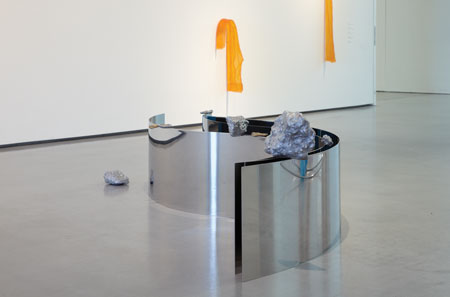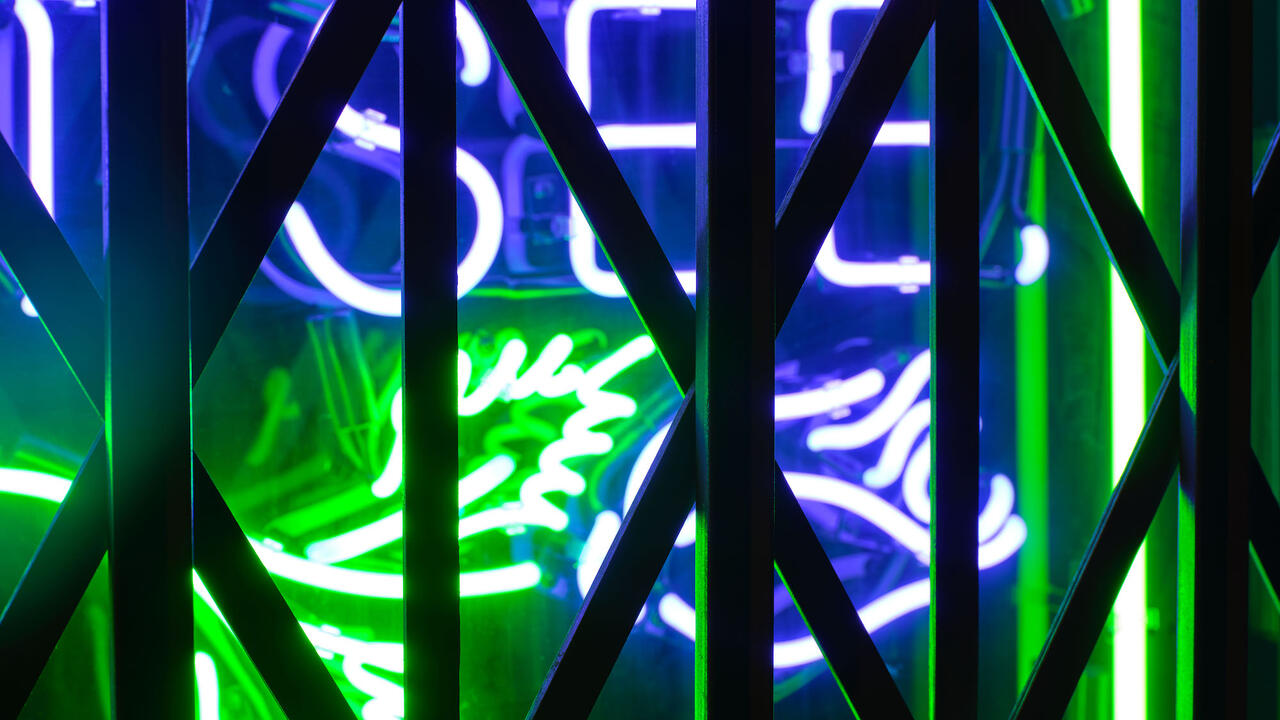Alice Channer, Jessica Jackson Hutchins & Linder

Amongst the permanent collection of the Hepworth Wakefield, there is a plaster cast of Barbara Hepworth’s own hand accompanied by a quotation from her 1970 autobiography: ‘My left hand is my thinking hand […] The rhythms of thought pass through the fingers and grip of this hand into the stone. It is also a listening hand.’ Thought, for Hepworth, was embodied, felt in the rough tips of the fingers against stone. Led by the sculptor’s thinking hand, three concurrent exhibitions explored the question of what a body is or might be, as substance and sensation.
Collectively titled ‘Invertebrates’ (all works 2013), Alice Channer’s new series of work was organized around a central Spine of resin slivers, cast from stirrup leggings, which snaked stiffly over chromed aluminium tubes. Hooked fronds of resin, like flattened sea-slugs, whose titles – MAF707G, MAR108, MAL001 – read as a litany of biological specimen numbers, were draped from the wall. With the luminous, viscous transparency of boiled sweets, they were awkwardly amorphous, holding their shapes but only just. From the heavy drapes of printed crepe de Chine, which streamed from the ceiling to pool on the floor, to the curves of mirror-polished aluminium – a finish with its own skittish changeability – of the Invertebrates sculptures, there is an in-between liquidity to Channer’s work. Tentacles outstretched, it feels out the imprecise edges of form.
The London-based artist talks about her sculptures as being ‘figurative, but without a body’, whilst invertebrates, with their dispersed central nervous system, undermine the mind/body opposition. If they are unthinking bodies, might there be disembodied thoughts? What happens when we slip off our skins? Despite their archaic namesakes, Channer’s works ask digital questions, about the flatness screens and thought as code without substance or weight. Next door, Jessica Jackson Hutchins’s sculptures are more assured in their objecthood. Folding ladders form skeletons draped with paint-smeared tarpaulins on which rest ceramic forms. Ladders can be precarious supports, and falling down is always an option in these works: sofa springs sag (SAP, 2012); canvases slump heavily; rough-edged ceramics perch or learn; an old armchair nosedives onto the floor (Lascaux, 2012). There is pathos here, but also humour and warmth, a kind of lived-in intimacy. Jackson Hutchins’s sculptures are less about the physicality of bodies than the points of contact between them – the slight, still-warm impressions that we make when we press against each other, literally or metaphorically.
For this exhibition, her first in a public institution in the UK, the Portland-based artist decided not to have anything hanging from the walls, which left the works feeling slightly adrift, like huddled nomads in the high, expansive gallery. There was one exception: Rondamoo (2009/13), a modified version of an earlier piece, which lolled its bulbous, papier-maché head against the wall in a gesture of despondency or fatigue. Like its child’s nonsense name, Rondamoo is a poignant lone attempt to communicate with the space around it, which is illogically, inexplicably intelligible.
Linder’s exhibition attempted a more direct communication with Hepworth herself. In one room, a series of small-scale collages (from 2012) communed around a totemic Hepworth marble, while in a darkened second room, a broken standing-stone circle of monolithic light-boxes was to be traversed whilst listening, on headphones, to an audio recording of her voice. The clips played over the background rumble of an octobass – an enormous stringed instrument of which there are only four in the world, the octobass is felt as much as heard, as a kind of otherworldly vibration. Filled with mid-century photographs of ballet dancers lushly collaged with jewel-bright animals, plants and flowers, the light-boxes were luminous windows into fairytale worlds.
In a sense, this was a family-friendly departure from the X-rated collages for which Linder has become well known. Aggressive sexuality has been replaced by a suggestive, Earth-Mother fecundity. But they are also a continuation of the artist’s career-long interest in artifice and theatricality, where the body – particularly the female body – is something to be performed. Different stages require different kinds of performance, but the beauty of collage is that it flattens indiscriminately, compressing multiple scenarios onto the same pictorial plane. The ballet set, the porn shoot and the domestic interior are all equally flimsy realities, to be sliced through indiscriminately by the scalpel blade.
Linder’s smaller collages showed images from women’s fashion glossies overlaid with objects cut from furniture catalogues of the same period (the years preceding Hepworth’s death in 1975). In their neat-edged juxtaposition of objects and settings, these works condense an era of heightened tension between the expectations of female liberation and the age-old demands of domesticity, with the boxy sideboard as shackle, weighing down the wafty skirts and wide-legged trousers.
Nowhere in the information about these ‘separate but linked’ exhibitions was it acknowledged that what might connect the three artists – to each other and to Hepworth – was a common interest in what it is to be a body, as well as a shared gender. Gender ought to be a purely formal concern, a difference in shape, with little bearing on our experience of ourselves as objects or our expression of ourselves as subjects. But I’m not so sure. And somehow, by shying away from the question, the gallery missed an opportunity for these bold and intelligent exhibitions to contribute something to the discussion.















